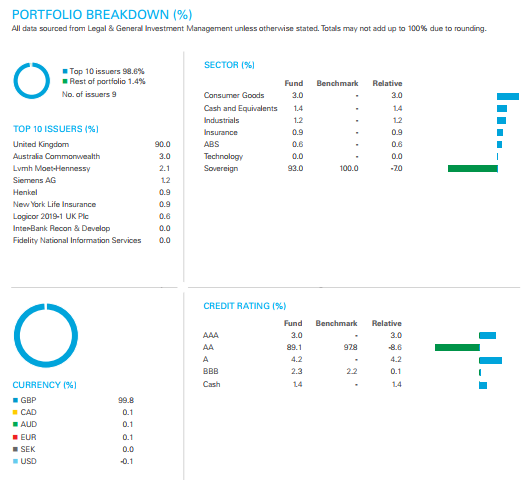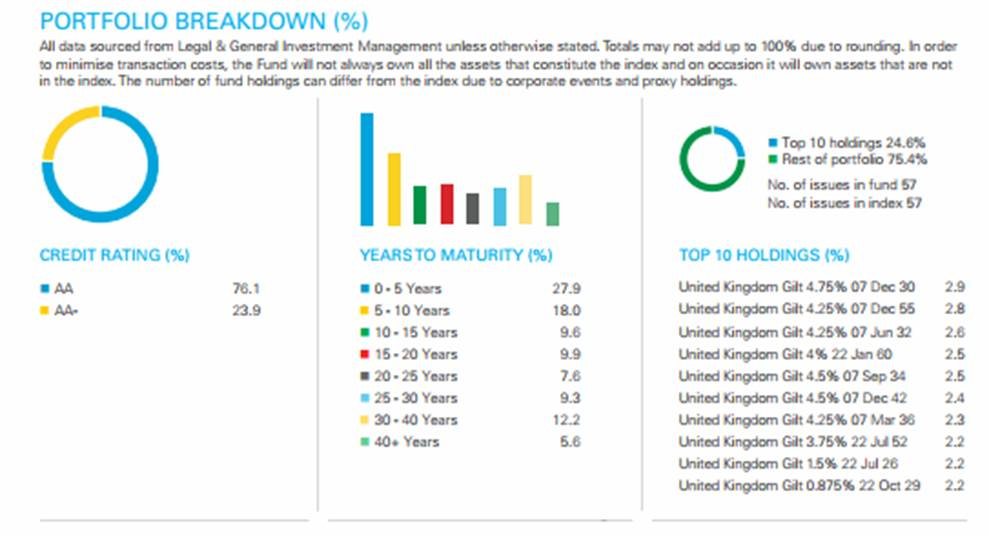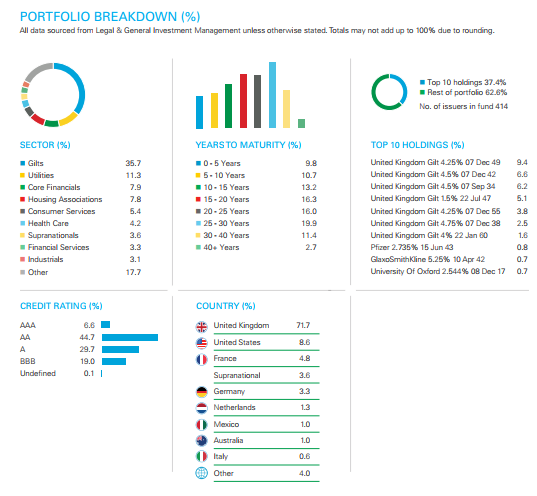We’d like to remind Forumites to please avoid political debate on the Forum.
This is to keep it a safe and useful space for MoneySaving discussions. Threads that are – or become – political in nature may be removed in line with the Forum’s rules. Thank you for your understanding.
The MSE Forum Team would like to wish you all a Merry Christmas. However, we know this time of year can be difficult for some. If you're struggling during the festive period, here's a list of organisations that might be able to help
📨 Have you signed up to the Forum's new Email Digest yet? Get a selection of trending threads sent straight to your inbox daily, weekly or monthly!
Has MSE helped you to save or reclaim money this year? Share your 2025 MoneySaving success stories!
Which bond index funds to balance portfolio?
Comments
-
That's what I do for the bond portion of my portfolio. I once owned a US (domestic) bond index fund, but I when I reduced my bond holding I decided to sell that leaving my Wellesley multi-asset income fund which has 60% government and investment grade corporate bonds and 40% dividend stocks with the goal of producing income. The average duration of the bonds is 8 years.Thrugelmir said:
Why not use a managed asset fund to achieve your objectives? It's constantly shifting sands out in the markets at the moment. You'll be behind the curve.Victorwelldue said:I've pretty much settled on a 70% equity / 30% bond split for my workplace pension and I'm fairly happy with my equity fund choices but I'm more perplexed by which bond funds to choose.
So I'm trying to understand what are the characteristics of bond index funds that I should be looking for, for this purpose. For example:- Stick to UK or diversify with world? (If so in which proportions?)
- Stick to Gilts & T-Notes or diversify with corporate? (If so in which proportions?)
- Inflation index linked or not?
- High yield or not?
- Maturing over 5 years? 15 years? Does this even matter when it will only be index funds anyway?
- Diversify over multiple bond index funds or just stick to one or two?
- Are bonds enough? I also have limited choice to a couple of cash & property funds - should these be considered too?
“So we beat on, boats against the current, borne back ceaselessly into the past.”0 -
And to ram home the point, from a related post:'I'm going to look at two data sets that both go back far enough to include the last period of rising rates, about 1940-1980. The first is not an actual fund but it does includes the whole period: the Ibbotson SBBI data series for "intermediate-term government bonds."https://www.bogleheads.org/forum/viewtopic.php?f=10&t=367330&p=6440239#p6440239
Ibbotson series:
From 1926 through 2020 there were 2 times when annual returns for intermediate-term government bonds were negative for two years in a row. There have not yet been three negative years in a row.
1954 2.68%
1955 -0.65%
1956 -0.42%
1957 7.84%
1958 -1.29%
1959 -0.39%
1960 11.76%
0 -
Thanks for everyone's input. I've found it all interesting but while learning more & more, a lot of it still above my head.
In one of my original threads my gripe was that L&G didn't have a pre-made multi-asset fund I could choose in my workplace pension aside from their default fund which is only 38% equities. Lots of people helped with suggestions and there were also a few comments along the lines of "you can make your own" which is obviously true but if anything reading this thread makes me stand by my original gripe even more i.e its a shame L&G don't have pre-made funds for people like me with (slightly) higher risk appetite but very limited investing knowledge.
Anyhow I think my main takeaway from reading this thread and the linked Monevator article is that for the bonds proportion of my portfolio I ideally want to be focused on high quality UK/GBP government bonds/gilts but I'm still not exactly sure which funds best meet this requirement, so I've attempted to filter down from the 19 fixed interest funds I can choose from and have come up with the following 3 choices. It would be great to get everyone's opinions on these 3 funds:
Option 1
L&G PMC Fixed Interest Fund 3 - B9M3 (Active, 0.09% charges)
FUND AIM
To maximise returns by investing in UK Government stocks and other readily marketable fixed interest securities. The fund may also include stocks of overseas governments and companies.
Option 2
L&G PMC All Stocks Gilts Index Fund 3 - NBY3 (Passive, 0.08% charges)
FUND AIM
To track the performance of the FTSE A Government (All Stocks) Index (including re-invested income) to within +/- 0.25% each year for two years out of three.
Option 3
L&G PMC PreRetirement Fund 3 - NEN3 (Passive, 0.12% charges)
FUND AIM
To provide diversified exposure to assets that reflect the broad characteristics of investments underlying a typical traditional level
annuity product.

0 -
8 years is still a long time in the current phase. As much will depend on the speed with which Central Banks taper their support. The Fed first used QE in 2008. Hard to believe we've had 14 years of cheap money now. Without any doubt has underpinned the bull market in equities over the corresponding period as well.bostonerimus said:
That's what I do for the bond portion of my portfolio. I once owned a US (domestic) bond index fund, but I when I reduced my bond holding I decided to sell that leaving my Wellesley multi-asset income fund which has 60% government and investment grade corporate bonds and 40% dividend stocks with the goal of producing income. The average duration of the bonds is 8 years.Thrugelmir said:
Why not use a managed asset fund to achieve your objectives? It's constantly shifting sands out in the markets at the moment. You'll be behind the curve.Victorwelldue said:I've pretty much settled on a 70% equity / 30% bond split for my workplace pension and I'm fairly happy with my equity fund choices but I'm more perplexed by which bond funds to choose.
So I'm trying to understand what are the characteristics of bond index funds that I should be looking for, for this purpose. For example:- Stick to UK or diversify with world? (If so in which proportions?)
- Stick to Gilts & T-Notes or diversify with corporate? (If so in which proportions?)
- Inflation index linked or not?
- High yield or not?
- Maturing over 5 years? 15 years? Does this even matter when it will only be index funds anyway?
- Diversify over multiple bond index funds or just stick to one or two?
- Are bonds enough? I also have limited choice to a couple of cash & property funds - should these be considered too?
0 -
If I'm understanding your comment correctly its because I have limited choices to choose from within my workplace pension. Its either the safe default multi-asset fund with 38% equities or DIY from the choices available.Thrugelmir said:
Why not use a managed asset fund to achieve your objectives? It's constantly shifting sands out in the markets at the moment. You'll be behind the curve.0 -
8 years is longer than some and shorter than some. For me it's a long term buy and hold and all the dividends from the bonds and corporate stocks get ploughed back so I should be buying low if interest rates go up.Thrugelmir said:
8 years is still a long time in the current phase. As much will depend on the speed with which Central Banks taper their support. The Fed first used QE in 2008. Hard to believe we've had 14 years of cheap money now. Without any doubt has underpinned the bull market in equities over the corresponding period as well.bostonerimus said:
That's what I do for the bond portion of my portfolio. I once owned a US (domestic) bond index fund, but I when I reduced my bond holding I decided to sell that leaving my Wellesley multi-asset income fund which has 60% government and investment grade corporate bonds and 40% dividend stocks with the goal of producing income. The average duration of the bonds is 8 years.Thrugelmir said:
Why not use a managed asset fund to achieve your objectives? It's constantly shifting sands out in the markets at the moment. You'll be behind the curve.Victorwelldue said:I've pretty much settled on a 70% equity / 30% bond split for my workplace pension and I'm fairly happy with my equity fund choices but I'm more perplexed by which bond funds to choose.
So I'm trying to understand what are the characteristics of bond index funds that I should be looking for, for this purpose. For example:- Stick to UK or diversify with world? (If so in which proportions?)
- Stick to Gilts & T-Notes or diversify with corporate? (If so in which proportions?)
- Inflation index linked or not?
- High yield or not?
- Maturing over 5 years? 15 years? Does this even matter when it will only be index funds anyway?
- Diversify over multiple bond index funds or just stick to one or two?
- Are bonds enough? I also have limited choice to a couple of cash & property funds - should these be considered too?
“So we beat on, boats against the current, borne back ceaselessly into the past.”0 -
I agree you are unlikely to see a major step change in interest rates, though they could vary a lot over a small number of years.JohnWinder said:For example there is a Gilt maturing in 2055 at a price of £182. You know with absolute certainty that the price will be £100 in 2055. ...
Equally, if you buy a long dated bond now paying 1.25% interest it would cost you about £100.Were general interest rates to rise to 4% today its value would also halve.This alludes to the relationship between interest rates and bond prices: as rates rise, bond prices fall, roughly by the duration times the % rise, so a 20 year duration fund would fall 40% with a 2% interest rate rise. It's a handy way to think of this relationship, but it grossly oversimplifies and can misrepresent the reality.Firstly, which interest rates are we talking about? If it's the central bank rate, then this has a limited and very indirect effect on longer term bond rates. Secondly, interest rates customarily don't exhibit step rises/falls of the 2% variety; central banks move their rates by fractions of a percent, and markets move longer bond rates by fractions of fractions each week/month. Thirdly, the OP is talking about bond funds, not bonds, and bond funds continually shed old (poor yielding) bonds and acquire new (higher yielding) bonds as interest rates rise thus ameliorating the effect of the interest rate change on the bonds' prices. With slow rises in interest rates you might not even be aware of the fund price falling. Fourthly, roll yield (explained at the bottom of p1 of the linked post) further ameliorates the price fall.See it all in graphic detail here: https://www.bogleheads.org/forum/viewtopic.php?t=360575
More importantly bond funds dont shed old poor yielding bonds and buy new high yielding bonds. The market ensures that all bonds of a given duration are priced to ensure equivalent total returns. At the moment it is old high yield bonds that are disappearing due to maturity being replaced by new very low yield bonds. When interest rates rise those new bonds will lose a significant amount of value to ensure that the effective bond interest rate matches the then current market rate.
For example on 22nd September 2021 a 0.875% gilt maturing in 2033 was issued at very close to £100. Thanks to the small rise in interest rates in the 4 months since then it is now worth £96.3. If in 3 years time interest rates were at 4% the price would be £77.7. If interest rates dropped to zero the price would be £107.50. Such figures lead me to believe that some-one wanting protection from equity falls would be better advised to use cash.
0 -
Option 3 has corporate bonds in addition to gilts, so it does not meet your criteria. Option 2 fits your criteria, and matches the suggestions in the Monevator article. Option 1 is a manged fund and has some corporate bonds, but not as many as Option 3. Its stated costs are higher than Option 2 and it will also have higher transaction costs.Victorwelldue said:Thanks for everyone's input. I've found it all interesting but while learning more & more, a lot of it still above my head.
In one of my original threads my gripe was that L&G didn't have a pre-made multi-asset fund I could choose in my workplace pension aside from their default fund which is only 38% equities. Lots of people helped with suggestions and there were also a few comments along the lines of "you can make your own" which is obviously true but if anything reading this thread makes me stand by my original gripe even more i.e its a shame L&G don't have pre-made funds for people like me with (slightly) higher risk appetite but very limited investing knowledge.
Anyhow I think my main takeaway from reading this thread and the linked Monevator article is that for the bonds proportion of my portfolio I ideally want to be focused on high quality UK/GBP government bonds/gilts but I'm still not exactly sure which funds best meet this requirement, so I've attempted to filter down from the 19 fixed interest funds I can choose from and have come up with the following 3 choices. It would be great to get everyone's opinions on these 3 funds:
Option 1
L&G PMC Fixed Interest Fund 3 - B9M3 (Active, 0.09% charges)
FUND AIM
To maximise returns by investing in UK Government stocks and other readily marketable fixed interest securities. The fund may also include stocks of overseas governments and companies.
Option 2
L&G PMC All Stocks Gilts Index Fund 3 - NBY3 (Passive, 0.08% charges)
FUND AIM
To track the performance of the FTSE A Government (All Stocks) Index (including re-invested income) to within +/- 0.25% each year for two years out of three.
Option 3
L&G PMC PreRetirement Fund 3 - NEN3 (Passive, 0.12% charges)
FUND AIM
To provide diversified exposure to assets that reflect the broad characteristics of investments underlying a typical traditional level
annuity product. 0
0 -
The Vanguard Global Bond Index fund has a buy swing factor of 16 basis points and a sell swing factor of 0 basis points (the NAV is calculated using bid prices, i.e. it is the liquidation value).GeoffTF said:
With its OEICs, Vanguard does its best to make sure that buyers and sellers pay the cost of creating and redeeming units. It does that with swing pricing:aroominyork said:I would be happy with the ETF's 7000 holdings rather than the OEIC's 15,000 - it's just that I tend to hold OEICs. The ETF charges 0.10% compared to the OEIC's 0.15% but the former has a c.0.16% buy/sell spread.
https://www.vanguard.co.uk/content/dam/intl/europe/documents/en/guide-to-swing-pricing.pdf
Trading has costs, whether you use the OEIC or the ETF. These costs are higher than they are for a simple gilt fund like VGOV, which has a narrower spread.
https://blog.indexacapital.com/wp-content/uploads/2019/09/plain-talk-guide-to-swing-pricing_v1-dutch-only-version_final-vam-2017-....pdf
You therefore potentially have a spread of 0.16% with the OEIC, if you buy when the cash inflow exceeds the threshold. There is a chance that you will get way Scot free if you buy on a day when few other people are doing the same. On a day like that, however, the ETF price is likely to sink to a discount of a similar amount. The Authorised Participants will not be able to do anything about that, because they would have to pay the spread in the underlying market.0 -
So it seems option 2 it is then! Thanks.GeoffTF said:
Option 3 has corporate bonds in addition to gilts, so it does not meet your criteria. Option 2 fits your criteria, and matches the suggestions in the Monevator article. Option 1 is a manged fund and has some corporate bonds, but not as many as Option 3. Its stated costs are higher than Option 2 and it will also have higher transaction costs.0
Confirm your email address to Create Threads and Reply

Categories
- All Categories
- 352.9K Banking & Borrowing
- 253.9K Reduce Debt & Boost Income
- 454.7K Spending & Discounts
- 246K Work, Benefits & Business
- 602.1K Mortgages, Homes & Bills
- 177.8K Life & Family
- 259.9K Travel & Transport
- 1.5M Hobbies & Leisure
- 16K Discuss & Feedback
- 37.7K Read-Only Boards




